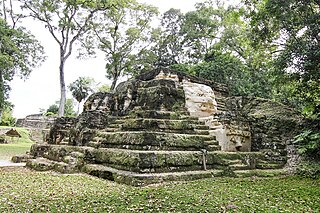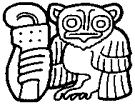
Copán is an archaeological site of the Maya civilization in the Copán Department of western Honduras, not far from the border with Guatemala. It is one of the most important sites of the Maya civilization, which was not excavated until the 19th century. The ruined citadel and imposing public squares reveal the three main stages of development before the city was abandoned in the early 10th century.

Dos Pilas is a Pre-Columbian site of the Maya civilization located in what is now the department of Petén, Guatemala. It dates to the Late Classic Period, and was founded by an offshoot of the dynasty of the great city of Tikal in AD 629 in order to control trade routes in the Petexbatún region, particularly the Pasión River. In AD 648 Dos Pilas broke away from Tikal and became a vassal state of Calakmul, although the first two kings of Dos Pilas continued to use the same emblem glyph that Tikal did. It was a predator state from the beginning, conquering Itzan, Arroyo de Piedra and Tamarindito. Dos Pilas and a nearby city, Aguateca, eventually became the twin capitals of a single ruling dynasty. The kingdom as a whole has been named as the Petexbatun Kingdom, after Petexbatún Lake, a body of water draining into the Pasión River.

Tikal is the ruin of an ancient city, which was likely to have been called Yax Mutal, found in a rainforest in Guatemala. It is one of the largest archeological sites and urban centers of the pre-Columbian Maya civilization. It is located in the archeological region of the Petén Basin in what is now northern Guatemala. Situated in Petén Department, the site is part of Guatemala's Tikal National Park and in 1979 it was declared a UNESCO World Heritage Site.

Uaxactun is an ancient sacred place of the Maya civilization, located in the Petén Basin region of the Maya lowlands, in the present-day department of Petén, Guatemala. The site lies some 12 miles (19 km) north of the major center of Tikal. The name is sometimes spelled as Waxaktun.

Yax Nuun Ahiin I, also known as Curl Snout and Curl Nose, was a 4th-century ruler of the Maya city of Tikal. His name, when transcribed, is YAX-?-AH:N, translated "First ? Crocodile". He took the throne on 12 September 379 and reigned until his death. He is referred to by the Mayan title ajaw, meaning lord.
Siyaj Kʼakʼ, also known as Fire is Born, was a prominent political figure mentioned in the glyphs of Classic Period (250–800 CE) Maya civilization monuments, principally Tikal, as well as Uaxactun and the city of Copan. Epigraphers originally identified him by the nickname "Smoking Frog", a description of his name glyph, but later deciphered it as Siyaj Kʼakʼ, meaning "Fire is born". He is believed by some to have been the general of the Teotihuacano ruler Spearthrower Owl.

El Perú, is a pre-Columbian Maya archeological site occupied during the Preclassic and Classic cultural chronology periods. The site was the capital of a Maya city-state and is located near the banks of the San Pedro River in the Department of Petén of northern Guatemala. El Perú is 60 km (37 mi) west of Tikal.

Calakmul is a Maya archaeological site in the Mexican state of Campeche, deep in the jungles of the greater Petén Basin region. It is 35 kilometres (22 mi) from the Guatemalan border. Calakmul was one of the largest and most powerful ancient cities ever uncovered in the Maya lowlands.

Kʼinich Yax Kʼukʼ Moʼ is named in Maya inscriptions as the founder and first ruler, kʼul ajaw, of the pre-Columbian Maya civilization polity centered at Copán, a major Maya site located in the southeastern Maya lowlands region in present-day Honduras. The motifs associated with his depiction on Copán monuments have a distinct resemblance to imagery associated with the height of the Classic-era center of Teotihuacan in the distant northern central Mexican region, and have been interpreted as intending to suggest his origins and association with that prestigious civilization. He is the founder of the Yax Kuk Mo Dynasty of rulers of Copan that lasted until 822 a.C. One of the most commonly cited motifs for this interpretation is the "goggle-eyed" headdress with which Yax Kʼukʼ Moʼ is commonly depicted; this is seemingly an allusion to the northern central Mexican rain deity known as Tlaloc by later peoples, such as the Aztecs. However, modern strontium isotope analysis of the human remains recovered from the tomb attributed to him indicate that Kʼinich Yax Kʼukʼ Moʼ spent his formative years much closer to Copán, at Tikal, and had not himself lived at Teotihuacan.

Linda Schele was an American Mesoamerican archaeologist who was an expert in the field of Maya epigraphy and iconography. She played a central role in the decoding of much of the Maya script. She produced a massive volume of drawings of stelae and inscriptions, which, following her wishes, are free for use to scholars. In 1978, she founded the annual Maya Meetings at The University of Texas at Austin.

Uaxaclajuun Ubʼaah Kʼawiil, was the 13th ajaw or ruler of the powerful Maya polity associated with the site of Copán in modern Honduras. He ruled from January 2, 695, to May 3, 738.
Río Azul is an archaeological site of the Pre-Columbian Maya civilization. It is the most important site in the Río Azul National Park in the Petén Department of northern Guatemala, close to the borders of Mexico and Belize. Río Azul is situated to the southeast of the Azul river and its apogee dates to the Early Classic period.
Maya monarchs, also known as Maya kings and queens, were the centers of power for the Maya civilization. Each Maya city-state was controlled by a dynasty of kings. The position of king was usually inherited by the oldest son.

Chak Tok Ichʼaak I also known as Great Paw, Great Jaguar Paw, and Toh Chak Ichʼak was an ajaw of the Maya city of Tikal. He took the throne on 7 August 360 and reigned until his death in 378, apparently at the hands of invaders from central Mexico.
Kʼakʼ Tiliw Chan Chaak [kʼakʼ tiliw tʃan tʃaːk], alternatively known by the nickname Smoking Squirrel bestowed before his name glyph was deciphered, was a Maya ruler of Naranjo. He led the city during an extensive military campaign against Yaxha; however, because of his young age at the time, it is presumed that his mother organized much of the campaign.

Maya stelae are monuments that were fashioned by the Maya civilization of ancient Mesoamerica. They consist of tall, sculpted stone shafts and are often associated with low circular stones referred to as altars, although their actual function is uncertain. Many stelae were sculpted in low relief, although plain monuments are found throughout the Maya region. The sculpting of these monuments spread throughout the Maya area during the Classic Period, and these pairings of sculpted stelae and circular altars are considered a hallmark of Classic Maya civilization. The earliest dated stela to have been found in situ in the Maya lowlands was recovered from the great city of Tikal in Guatemala. During the Classic Period almost every Maya kingdom in the southern lowlands raised stelae in its ceremonial centre.

Tikal Temple 33 was a 33-metre-high (108 ft) ancient Maya funerary pyramid located in the North Acropolis of the great Maya city of Tikal. The pyramid was centrally situated in the front row of structures facing onto the Great Plaza, between Temples 32 and 34 and in front of the Northern Platform. Temple 33 is one of the most thoroughly explored temples in the entire Maya area. The earliest version was a low funerary shrine over the tomb of king Siyaj Chan K'awiil II, which was sealed in AD 457. Temple 33 underwent three consecutive phases of construction, during which the king's funerary shrine was remodelled and one of his stelae was interred above his tomb. In the mid-1960s, archaeologists completely dismantled the final version of the large pyramid, uncovering the earlier phases of construction.

The North Acropolis of the ancient Maya city of Tikal in Guatemala is an architectural complex that served as a royal necropolis and was a centre for funerary activity for over 1300 years. The acropolis is located near the centre of the city and is one of the most studied of Maya architectural complexes. Excavations were carried out from 1957 to 1969 by the University of Pennsylvania, directed by Edwin M. Shook and William Coe.
The Leyden plaque, sometime called Leiden plate or Leiden plaque, is a jadeite belt plate from the early classic period of the Maya civilization. Although the plate was found on the Caribbean coast, it may have been made in Tikal. The plate is now in the National Museum of Ethnology in Leiden, Netherlands, hence its official name. It is one of the oldest Maya objects using the Mesoamerican Long Count calendar.

The Yax Kuk Mo dynasty was the royal house that reigned in the city-state of Copan (Oxwitik) for four centuries. This was installed in the city in the year 426 a.C, due to Teotihuacan influence and military support from the ruler Sihyaj Chan K'awiil II of Tikal, who ruled between the 5th and 9th centuries. The architectural works built in Copán during the rule of the Yax K'uk Mo' dynasty are preserved to this day, being accessible to the general public. Yax Kuk Mo In mayan means First Quetzal Macaw.
















